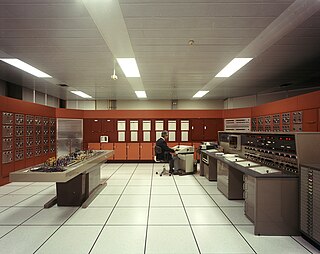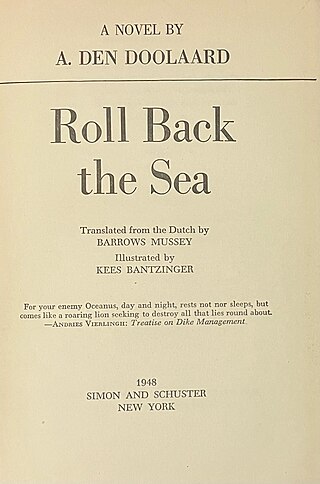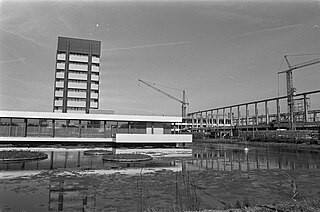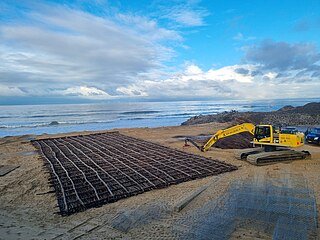
The Zuiderzee Works is a system of dams and dikes, land reclamation and water drainage work, which was the largest hydraulic engineering project undertaken by the Netherlands during the twentieth century. The project involved the damming of the Zuiderzee, a large, shallow inlet of the North Sea, and the reclamation of land in the newly enclosed water using polders. Its main purposes are to improve flood protection and create additional land for agriculture.

Sliedrecht is a town and municipality in the western Netherlands, in the province of South Holland. The municipality covers an area of 14.01 km2 (5.41 sq mi) of which 1.17 km2 (0.45 sq mi) is covered by water.

The Afsluitdijk is a major dam and causeway in the Netherlands. It was constructed between 1927 and 1932 and runs from Den Oever in North Holland province to the village of Zurich in Friesland province, over a length of 32 kilometres (20 mi) and a width of 90 metres (300 ft), at an initial height above Amsterdam Ordnance Datum of between 6.7 metres (22 ft) along the section at Friesland, and 7.4 metres (24 ft) where it crosses the deep channel of the Vlieter. The height at the greater sea depths west of Friesland was required to be a minimum of 7 metres everywhere when originally constructed.

The Afgedamde Maas is a former distributary of the Maas River in the Dutch provinces of North Brabant and Gelderland. The Maas splits near Heusden with one channel flowing north until its confluence with the river Waal to form the Merwede, while the other channel continues west as the main distributary of the Maas.

The Oosterscheldekering, between the islands Schouwen-Duiveland and Noord-Beveland, is the largest of the Delta Works, a series of dams and storm surge barriers, designed to protect the Netherlands from flooding from the North Sea. The construction of the Delta Works was a response to the widespread damage and loss of life in the North Sea flood of 1953.

The Rotterdamsche Droogdok Maatschappij (RDM) was the largest pre-World War II shipbuilding and repair company in Rotterdam in the Netherlands, existing from 1902 to 1996. It built 355 mostly major seagoing vessels, 18 of which were submarines. During its existence, the wharf operated 12 floating docks and in its heyday employed 7,000 people at one time.

Boskalis Westminster N.V. is a Dutch dredging and heavylift company that provides services relating to the construction and maintenance of maritime infrastructure internationally. The company has one of the world's largest dredging fleets, a large stake in Smit International and owns Dockwise, a large heavylift shipping company.

The Deltar was an analogue computer used in the design and execution of the Delta Works from 1960 to 1984. Originated by Johan van Veen, who also built the initial prototypes between 1944 and 1946, its development was continued by J.C. Schönfeld and C.M. Verhagen after van Veen's death in 1959.

Johannes Aleidis (Johan) Ringers was a Dutch hydraulic engineer and politician. He served as the director-general of Rijkswaterstaat and later as the director of Dutch East Indies Railways. During World War II, Ringers was appointed as the government commissioner for reconstruction, but was later interned by German forces.

Hollandsche Beton Groep nv (HBG) was a Netherlands-based construction group founded in 1902. It expanded internationally in the late 20th century, acquiring businesses in the United Kingdom, before being itself acquired by Netherlands competitor Royal BAM NBM to form the Royal BAM Group.

Land reclamation in the Netherlands has a long history. As early as in the 14th century, the first reclaimed land had been settled. Much of the modern land reclamation has been done as a part of the Zuiderzee Works since 1919.

Royal IHC or Koninklijke IHC, previously IHC Holland (1943–1995), IHC Holland Merwede (1995–2005) and IHC Merwede (2005–2014) is a Dutch shipbuilding company with headquarters in Kinderdijk. It focuses on the development, design and construction of ships for the dredging and offshore industries.

Elizabeth Frederika van den Ban, known as Elze, was a Dutch urban planner and chief engineer of the Rijkswaterstaat at Zuiderzee Works where she introduced curvatures rather than straight lines into the urban planning process of polders and dikes. Van den Ban was the first woman from the Netherlands to graduate as a civil engineer in Delft, where she worked as a civil engineer.

Het verjaagde water is a 1947 Dutch non-fiction novel written by A. den Doolaard, which gives an account of the recovery works to repair dike breaches after the October 1944 Inundation of Walcheren as part of operations by The Allies of World War II during Operation Infatuate. Researchers from Delft University of Technology have found high levels of historical accuracy in den Doolaard's descriptions of the events that took place, the methods used to close the dikes and the key people involved. Den Doolaard assigned pseudonyms to most of the main characters and organisations. The name A. den Doolaard is also a pseudonym, the author’s real name being Cornelis Johannes George Spoelstra Jr.
Jo Johannis Dronkers was a Dutch mathematician who is notable for the development of mathematical methods for the calculation of tides and tidal currents in estuaries. His work formed much of the mathematical basis for the design of the Delta Works. He attended the 1954 International Congress of Mathematicians in Amsterdam, where his work was discussed by David van Dantzig.

Johannes Theodoor Thijsse was a Dutch hydraulic engineer who made significant contributions to hydraulic engineering both in The Netherlands and internationally. In addition to having a major involvement in the design and planning of both the Zuiderzee Works and the Delta Works, he published widely and played a key role in the establishment of the IHE Delft Institute for Water Education.

The Waterloopkundig Laboratorium was an independent Dutch scientific institute specialising in hydraulics and hydraulic engineering. The laboratory was established in Delft from 1927, moving to a new location in the city in 1973. The institute later became known as WL | Delft Hydraulics. In 2008, the laboratory was incorporated into the international nonprofit Deltares institute.

Pieter Philippus Jansen was a Dutch civil engineer and hydraulic engineer who made significant contributions to hydraulic engineering in The Netherlands. He spent the majority of his career with Rijkswaterstaat, working on several major projects including the first phase of the Delta Works and leading the reclamation and repair efforts following the inundation of Walcheren.

Jan Fokke Agema was a Dutch hydraulic engineer and professor at Delft University of Technology. He is notable for his design of the harbour entrance at Hoek van Holland and involvement in the construction of the Oosterscheldekering. The prof. dr.ir. J.F. Agemaprijs is named for him, and has been awarded every five years since 2000.

A fascine mattress(Dutch: Zinkstuk, literally sink piece), is a large woven mat made of brushwood, typically willow twigs and shoots, used to protect riverbeds and other underwater surfaces from scour and erosion. They are similar in construction to a fascine, but are primarily used for hydraulic engineering works, typically to strengthen the banks of rivers and streams, as well as coastal structures like revetments and groynes.



















